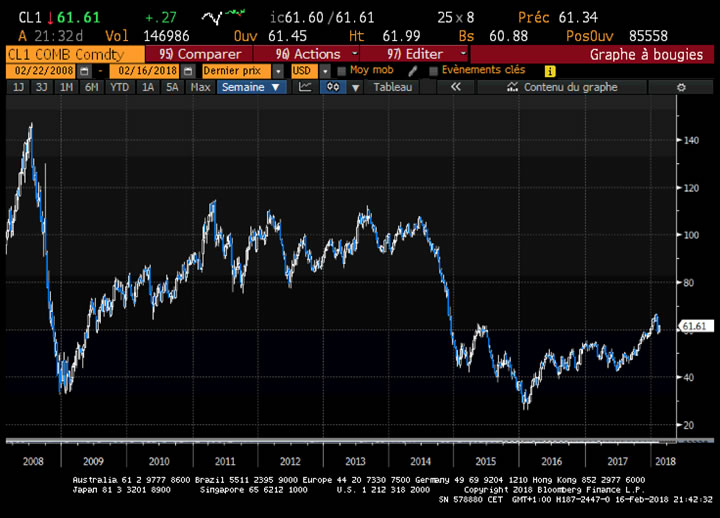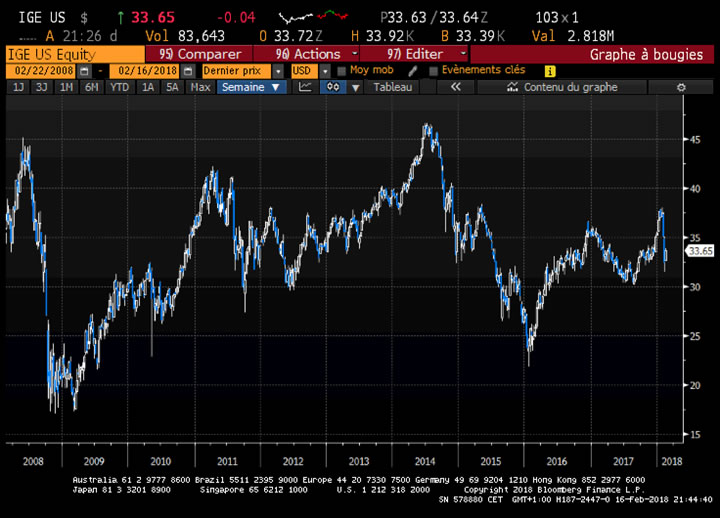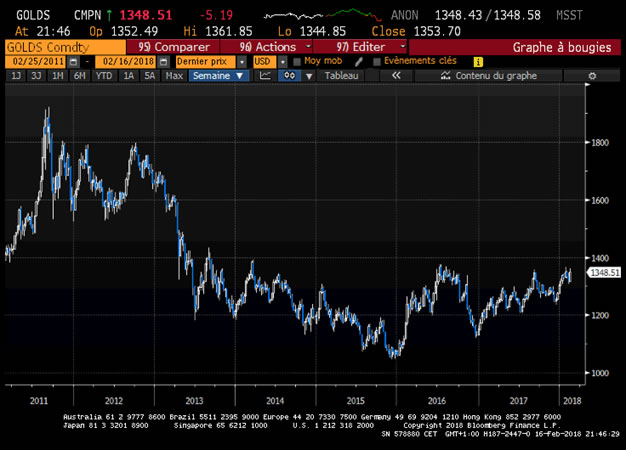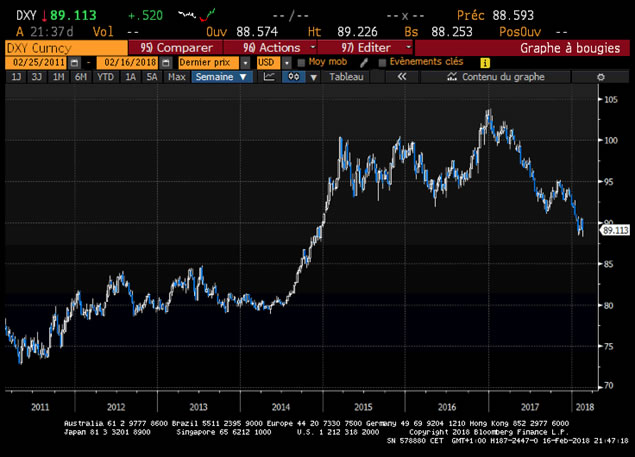Crude Oil Prices: A Case of Dueling Narratives?
Commodities / Crude Oil Feb 17, 2018 - 02:04 PM GMTBy: WMA
 There are indications Crude Oil prices are going lower. There are also indications that it’s going higher. Which narrative do you believe?
There are indications Crude Oil prices are going lower. There are also indications that it’s going higher. Which narrative do you believe?
Oil Bears point to what they believe is over-supply caused by soaring US production, mostly from shale fields. With production increasing over +20% in less than two years, and drill rigs on the rise, the US now produces about as much Oil as the industry leaders, Saudi Arabia and Russia. According to the Oil Bears, the Saudi-Russia pact to restrain global production and export levels will break down in 2018, thereby leading to more supply than demand, causing lower prices. Moreover, the Bears are confident that alternative energy supply (e.g., solar/battery and uranium) will eventually win out as it is a cheaper and cleaner power source, and that Electric Vehicles are increasingly favored by consumers.
The Oil Bulls, on the other hand, believe that the Saudi-Russia pact with many other producing states has been quite effective in restraining Oil supply in the past year and will be an effective rebalancing tool going forward. Moreover, the Oil Bulls argue that economic sustainability for the industry can only be achieved with higher Oil prices as discovery, production and delivery costs are rising quickly and much lower industry capex has reduced reserves that will ultimately be drawn down to where they cannot meet the demands of a rapidly growing world economy. The whole alternative energy argument, the Oil Bulls argue, may become a reality in 10 to 20 years, but for now is not pushing Oil prices lower.
Both arguments have merit. Neither is conclusive. It’s possible, even, that both sides are losers, played off by the powers-that-be, the ones who ultimately control the narrative.
While there is much talk about how social media’s Google and Facebook are controlling the important narratives in mass media today, we think that’s mostly about political, lifestyle and cultural issues. We have long held the belief that who controls the world’s money has effective control over matters of economics, business and finance, including Oil.
So, let’s consider for a moment the bigger picture, the one about who controls the world’s money.
The usual names uncovered by legitimate research include the Rothschilds, Rockefellers, Warburgs, Schiffs, Harrimans, Bush’s, DuPonts, Morgans, and so forth. These are the families widely believed to control the important Central Banks (Federal Reserve Bank of New York, the Bank of England and the European Central Bank among others in the G-20) as well as Humongous Bank & Broker (J.P. Morgan Chase, Goldman Sachs, Citigroup, and Wells Fargo), and Big Oil (Exxon Mobil, Royal Dutch/Shell, BP Amoco and Chevron).
We cannot ignore that it was Baron Nathan Mayer de Rothschild himself who said: “I care not what puppet is placed on the throne of England to rule the British Empire on which the sun never sets. The man that controls Britain’s money supply controls the British Empire, and I control the British money supply.”
Whenever these names are discussed, those who do so are soon branded as conspiracy theorists. However, they have been in good company as US presidents have also spoken out about such a networked group of powerful people who manage to keep their affairs hidden for the most part.
Consider this statement from 28th US President Woodrow Wilson: “Since I entered politics, I have chiefly had men’s views confided to me privately. Some of the biggest men in the United States, in the field of commerce and manufacture, are afraid of something. They know that there is a power somewhere so organised, so subtle, so watchful, so interlocked, so complete, so pervasive, that they better not speak above their breath when they speak in condemnation of it.”
Consider the 1961 statement of the 35th US President John F. Kennedy (JFK): “The word secrecy is repugnant in a free and open society, and we are as a people, inherently and historically opposed to secret societies, secret oaths and secret proceedings. For we are opposed around the world by a monolithic and ruthless conspiracy, that relies primarily on covert means for expanding its sphere of influence. It depends on infiltration instead of invasion, on subversion instead of elections, on intimidation instead of free choice. It is a system which has conscripted vast human and material resources into the building of a tightly knit, highly efficient machine that combines military, diplomatic, intelligence, economic, scientific, and political operations. Its preparations are concealed, not published, its mistakes are buried, not headlined, and its dissenters are silenced, not praised, no expenditure is questioned, no secret revealed… I am asking your help in the tremendous task of informing and alerting the American people.”
JFK is probably the most interesting case. On June 4, 1963, he ordered the printing of Treasury dollar bills to replace Federal Reserve notes (Exec. Order 11110). He also ordered the withdrawal of the Federal Reserve notes. However, just five months later he was assassinated, following which his widow and family members did point fingers at the cabal. Not surprisingly, JFK’s successor, President Lyndon Johnson, immediately reversed the order to switch to Treasury Bills, arguably the likely (though unproven) reason why JFK had been murdered. Another order of JFK, to militarily disengage from the Far East by withdrawing US soldiers from Vietnam, was also immediately reversed after his death. Vietnam, we know, was a war that consumed massive amounts of oil and cabal-funded weaponry at hugely inflated prices.
But while this background is interesting, it’s also debatable, so let’s focus this discussion on what we know or think we know.
Whoever controls the world’s money controls oil, which they do through (i) political and military influence, (ii) control of capital markets and financial services, and (iii) equity ownership and board control.
Today, the people who control the world’s money do so through agents called central banks and the Bank for International Settlements, which is the banker to central banks. The key people presently in authority and control of the majority of the public’s money are not publicly elected or appointed. They are all ex-Goldman Sachs executives: (i) Bill Dudley, president of the Fed Bank of NY; (ii) Mario Draghi, president of the European Central Bank; and (iii) Mark Carney, governor of the Bank of England. The public-facing principal agents who serve these organizations are Goldman Sachs and JP Morgan Chase.
Oil prices are controlled by futures markets and any major international player in futures must be a member of the Fed, ECB and BoE. Every major international participant in the Oil market has access to the demand and supply information supplied by organizations such as EIA, API, IEA, and OPEC. Their inside access to information as well as influence over mass media, which controls the public narrative of anything of importance, is their power and what makes them winners.
As our job is to trade prices, let’s look at the big picture for Oil.
For the Oil futures price to rise significantly, the drivers must be one or more of (i) economic (GNP growth, inflation etc), (ii) military (threat of war or actual war) or (iii) financial (forex and rising interest rates without excessive monetary contraction). These factors take time to develop and play out. The interim reports that are published weekly and monthly garner the public’s attention but lead to relatively small changes in the Oil price.
During 2H2017 and 1Q2018, all the major drivers have been in play. It’s the narrative that is constantly changing, not the big picture. At times, the bull case may have greater merit and at times the bear case may have greater merit. At all times, vested interests are talking their book because to the public, price in the short-run is what matters.
But the important point is that in the long run neither bull or bear narrative matters. Oil prices will trend higher or lower depending on the longer-term investment interests of the powers-that-be that control Oil and that happens to be the people who control the world’s money and the financial system of which capital markets are a part. For those of us involved in capital markets, we must appreciate theirs is a game that is playing us in the short-run and our success depends of making good decisions for the long-run.
Every week in recent years, the Oil narrative has been focused on the EIA oil inventory report from the US government, data that is based on voluntary reporting and full of estimates. The public doesn’t question this. It should because WTI (West Texas Intermediate) is priced off hard data as measured by actual levels of the Oil in the storage tanks at Cushing, Oklahoma.
Cushing OK is the delivery point for NYMEX Oil futures contracts. It’s where crude oil supply sources meet crude demand sources. For us investors, then, monitoring inventory levels at Cushing is therefore a very important part of understanding what’s going to happen to WTI prices.
From Genscape.com
Genscape’s bi-weekly measurements of the oil storage tanks at Cushing, Oklahoma are the industry standard for the most important crude oil trading hub in the world. That’s because, unlike the Energy Information Administration’s (EIA) data derived from voluntary reporting or accounting flows, Genscape storage measurements are based on actual tank volumes and include granularity down to the individual tank level.
Data is collected using infrared cameras, aerial diagnostics, and other proprietary measurement techniques. This approach translates into highly accurate, advance notice of the actual oil storage levels at Cushing. Immediately following the publication of the Genscape’s Cushing oil storage numbers on Mondays and Thursdays at 10:00 AM (US Eastern time), futures and over-the-counter trading activity surges as market participants adjust their positions. In addition to offering insight into the industry’s most-watched hub two days ahead of the EIA, Genscape provides much more granular information to assess oil storage by owner or purpose.
Cushing is not the only location that influences the crude oil balance in the U.S. Mid-Continent. Genscape also measures tank levels in Canada, at Patoka in Illinois, at St. James in Louisiana, and at four separate locations in West Texas, including the critical Midland hub. The Canadian storage is particularly interesting to traders since tank levels at Hardisty in Alberta provide a good leading indicator of what to expect at Cushing three weeks later.
Here are the most recent Cushing Storage levels.
Week ending |
Inventory change |
Cushing Inventory |
08-Nov-17 |
0.720 |
64.560 |
15-Nov-17 |
-1.504 |
63.056 |
22-Nov-17 |
-1.827 |
61.229 |
29-Nov-17 |
-2.914 |
58.315 |
06-Dec-17 |
-2.753 |
55.562 |
13-Dec-17 |
-3.317 |
52.245 |
20-Dec-17 |
0.754 |
52.999 |
28-Dec-17 |
-1.584 |
51.415 |
04-Jan-18 |
-2.441 |
48.974 |
10-Jan-18 |
-2.395 |
46.579 |
18-Jan-18 |
-4.184 |
42.395 |
24-Jan-18 |
-3.150 |
39.245 |
31-Jan-18 |
-2.224 |
37.021 |
07-Feb-18 |
-0.711 |
36.310 |
14-Feb-18 |
-3.642 |
32.668 |
These facts – which have not been part of the narrative – show that Cushing inventory levels have been plunging for three months.
For the week ending Nov. 8, the level was 64.56 Mbbl (million barrels of Oil), which was about 69% of storage capacity. The latest data as reported Feb. 14, for the week ending Feb. 9, the level is down by half to just 32.67 Mbbl or roughly 35% of capacity. That happens to be just about 1.5 days of US consumption.
At no time in the past 10 years has Cushing inventory dropped so rapidly.
Over the past 14 weeks, weekly inventory reportedly grew only one time, and that by just 0.754Mbbl, whereas the other 13 weeks averaged a drop of -2.502Mbbl per week. Unless the process is reversed, Cushing will be out of inventory in another 13 weeks.
Let’s review the 10-year chart for WTI.

When Cushing inventory levels were building rapidly in 2H2014, the WTI price was collapsing, plunging over -50% from ~$105 to ~$45 in just 6 months and then to ~$30 a year later. That was a full drop in price of well over -70% in 18 months.
Over the past 3 months, however, during the time Cushing inventory has plunged by half, the price of WTI has lifted only about +33% from ~$45 to just over $60. The Bear narrative continues just as strong. Whatever the narrative, we believe the facts show that the price of WTI must continue higher or else Cushing inventory must start building rapidly to offset supply-based pricing pressure. It’s one or the other.
As asset allocators and investors in the energy space, we make strategic and tactical decisions based not on the competing narratives, but on major drivers, inventory facts and the fundamentals of each of the companies we invest in. The speculators who are focused on stories are the ones causing volatility.
Our research covers fundamental data over 3800 companies of which almost 300 are in Natural Resources, two-thirds of which are in Oil & Gas. Our extensive data shows which companies have comparatively superior operating results and balance sheets with fundamentally sound financial strength today and are geared for growth performance in the next year or two. These are the ones that investors want to be holding in portfolios.
Our Natural Resources fund is presently fully invested in 20 stocks in 10 industries. We hold positions in eleven Energy companies in six different industries, including Oil & Gas exploration & production, equipment & services, refining, frac sand, and Natural Gas production, storage and delivery, plus uranium and solar energy, as well as positions in gold and silver mining, copper mining and wood production.
Periodically in our reports and blogs, we discuss some of our portfolio holdings, but today we’re not about to talk our book. For now, we’ll close by saying we think we are well positioned to out-perform the iShares North American Natural Resources ETF (NYSE:IGE) benchmark over the next 3 to 9 months, and beyond.

We’ll need some help from the Gold market (top chart below), which appears to be on the verge of a break-out, as well as continuing weakness in the USD (bottom chart below).
Extreme volatility is a challenge for all of us, but, hopefully our readers, like us, will stick to the facts and ignore the competing narratives. Stories beget stories, which beget stories, as we have shown here today. It’s all interesting; it’s all debatable; but it does not lead to better investment performance.


By Williams Market Analytics
http://www.williamsmarketanalytics.com
We provide insightful market analysis and account management founded upon our very successful systematic, disciplined approach to investing. Our investment analysis revolves around two inputs: company valuation and our quantitative, market-based indicators. Learn more about our approach and our strategist.
© 2018 Copyright Williams Market Analytics - All Rights Reserved
Disclaimer: The above is a matter of opinion provided for general information purposes only and is not intended as investment advice. Information and analysis above are derived from sources and utilising methods believed to be reliable, but we cannot accept responsibility for any losses you may incur as a result of this analysis. Individuals should consult with their personal financial advisors.
© 2005-2022 http://www.MarketOracle.co.uk - The Market Oracle is a FREE Daily Financial Markets Analysis & Forecasting online publication.



